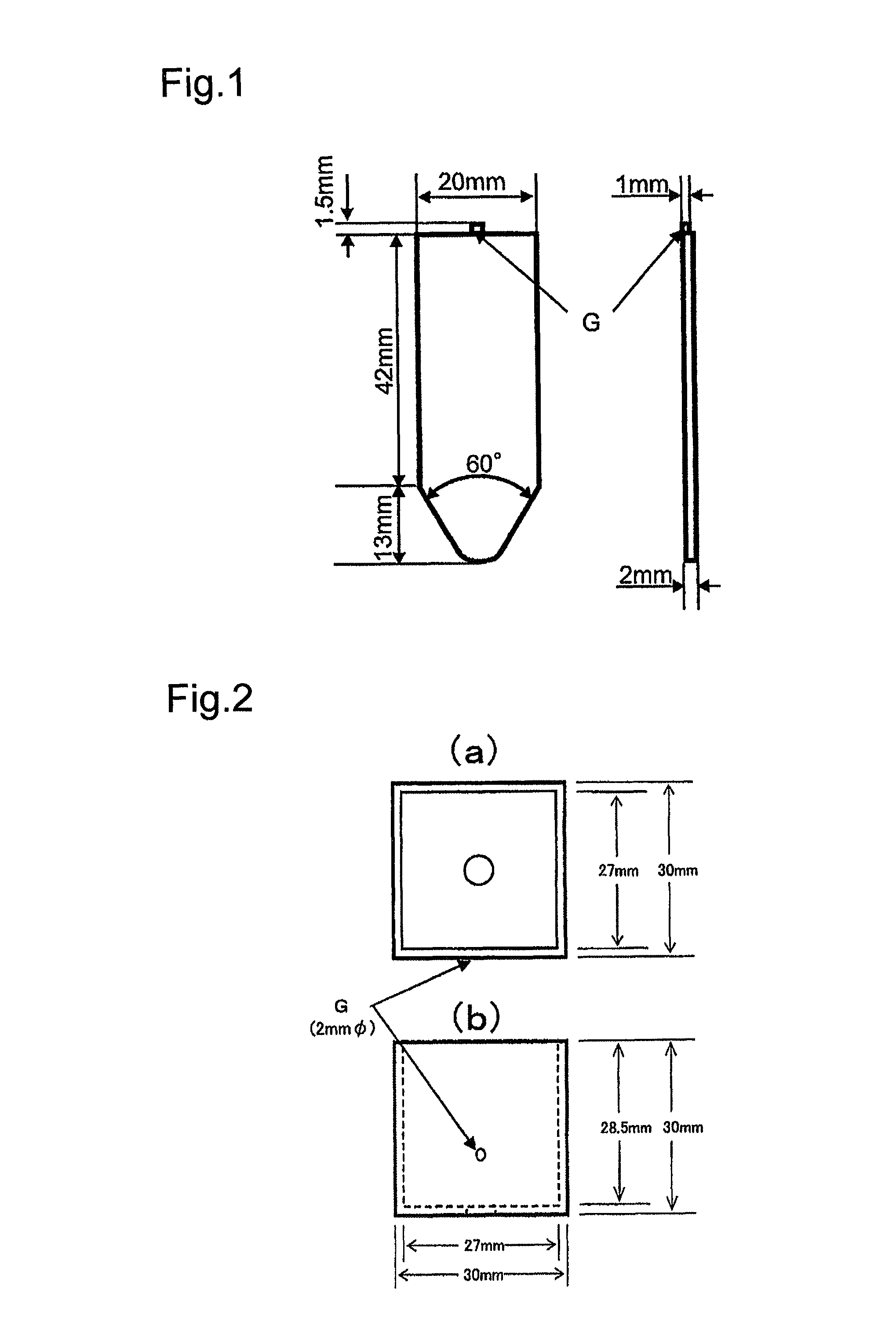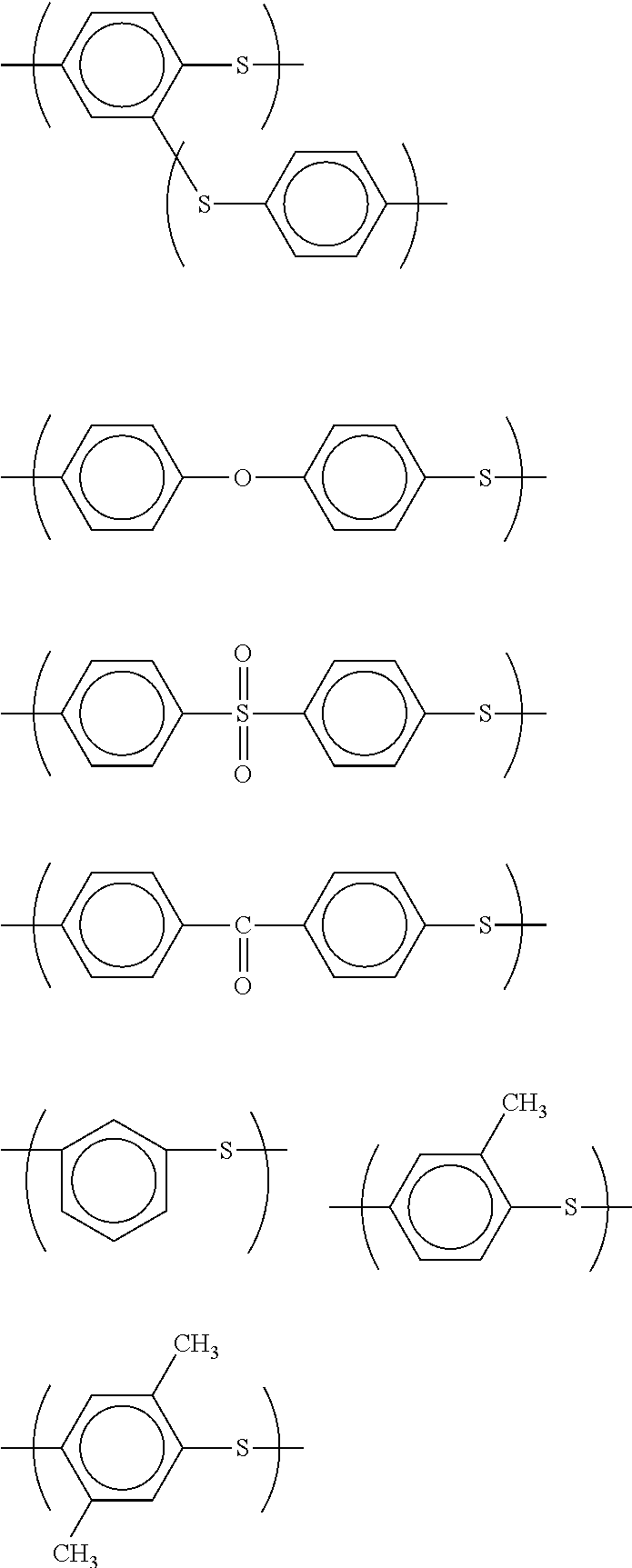Polyphenylene sulfide resin composition and molding comprising same
a polyphenylene sulfide resin and composition technology, applied in the field ofpp, can solve the problems of deteriorating molding processability, pps resin generally tends to have the lower toughness, and improves toughness, so as to improve heat resistance, improve mechanical properties, and good balance between heat resistan
- Summary
- Abstract
- Description
- Claims
- Application Information
AI Technical Summary
Benefits of technology
Problems solved by technology
Method used
Image
Examples
reference example 1
Polymerization of PPS Resin (A1)
[0151]The method placed 8.27 kg (70.00 mol) of 47.5% sodium hydrosulfide, 2.94 kg (70.63 mol) of sodium hydroxide 96%, 11.45 kg (115.50 mol) of N-methyl-2-pyrrolidone (NMP), 0.513 kg (6.25 mol) of sodium acetate and 3.82 kg of ion exchange water in a 70-liter autoclave with a stirrer and a bottom stop valve and gradually heated the mixture to 245° C. in about 3 hours at ordinary pressure with the nitrogen flow. After distillation of 8.09 kg of water and 0.28 kg of NMP, the reaction vessel was cooled down to 200° C. The remaining amount of water in the system per 1 mol of the fed alkali metal sulfide was 1.06 mol including water consumed for hydrolysis of NMP, and the release amount of hydrogen sulfide was 0.02 mol per 1 mol of the fed alkali metal sulfide. After cooling down to 200° C., the method added 10.34 kg (70.32 mol) of p-dichlorobenzene and 9.37 kg (94.50 mol) of NMP, sealed the reaction vessel under nitrogen gas, raised the temperature from 2...
reference example 2
Polymerization of PPS Resin (A2)
[0152]The method placed 8.27 kg (70.00 mol) of 47.5% sodium hydrosulfide, 2.96 kg (70.97 mol) of sodium hydroxide 96%, 11.45 kg (115.50 mol) of N-methyl-2-pyrrolidone (NMP), 2.58 kg (31.50 mol) of sodium acetate and 10.5 kg of ion exchange water in a 70-liter autoclave with a stirrer and gradually heated the mixture to 245° C. in about 3 hours at ordinary pressure with the nitrogen flow. After distillation of 14.78 kg of water and 0.28 kg of NMP, the reaction vessel was cooled down to 160° C. The remaining amount of water in the system per 1 mol of the fed alkali metal sulfide was 1.06 mol including water consumed for hydrolysis of NMP, and the release amount of hydrogen sulfide was 0.02 mol per 1 mol of the fed alkali metal sulfide. The method then added 10.24 kg (69.63 mol) of p-dichlorobenzene and 9.01 kg (91.00 mol) of NMP, sealed the reaction vessel under nitrogen gas and raised the temperature to 238° C. at a rate of 0.6° C. / minute with stirring...
reference example 3
Synthesis of Carboxylic Acid Amide Wax (C1)
[0153]After 1.97 mol of stearic acid and 0.32 mol of sebacic acid were placed in a reactor and were dissolved by heating, 1.37 mol of ethylene diamine was added little by little. The dehydration reaction started from 160° C. in nitrogen flow. After the reaction until reduction of the amine value to or below 5 at 250° C., wax was produced (C1 with alkyl group having the number of carbon atoms=17). This wax as a sample was subjected to differential scanning calorimetry under the conditions that the rate of temperature rise and the rate of temperature decrease were both 20° C. / minute, the scanning range was 50 to 170° C. and the amount of the sample was about 4 mg. The sample was scanned continually twice, and the value of a second melting peak was measured. An endothermic peak was observed at 143° C., and its heat quantity was 79 J / g. Ethylene bis-stearyl amide (corresponding to the reaction product that is the reactant of the higher aliphati...
PUM
| Property | Measurement | Unit |
|---|---|---|
| molding temperature | aaaaa | aaaaa |
| mol % | aaaaa | aaaaa |
| volume | aaaaa | aaaaa |
Abstract
Description
Claims
Application Information
 Login to View More
Login to View More - R&D
- Intellectual Property
- Life Sciences
- Materials
- Tech Scout
- Unparalleled Data Quality
- Higher Quality Content
- 60% Fewer Hallucinations
Browse by: Latest US Patents, China's latest patents, Technical Efficacy Thesaurus, Application Domain, Technology Topic, Popular Technical Reports.
© 2025 PatSnap. All rights reserved.Legal|Privacy policy|Modern Slavery Act Transparency Statement|Sitemap|About US| Contact US: help@patsnap.com



